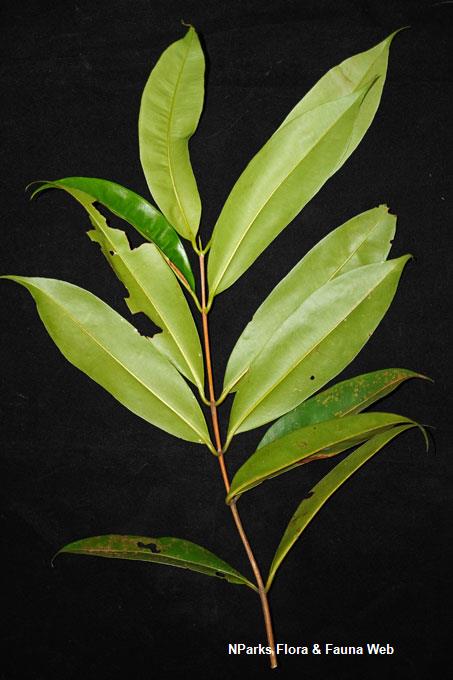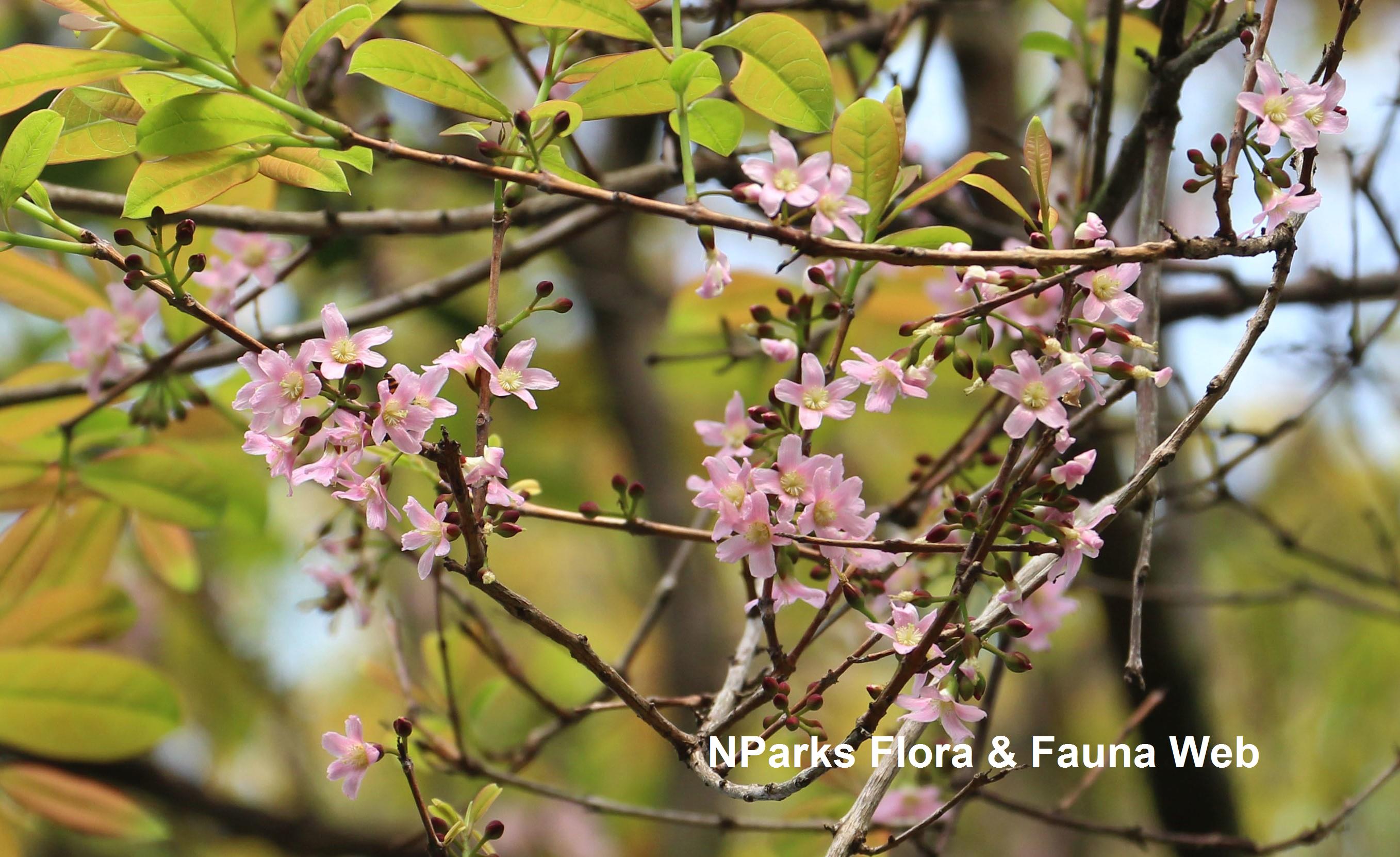.jpg)
Back
Cratoxylum arborescens (Vahl) Blume
| Family Name: | Hypericaceae |
| Synonyms: | Hypericum arborescens Vahl, Vismia arborescens (Vahl) Choisy |
| Common Name: | Geronggang |
Cratoxylum arborescens or Geronggang is a tall tree that reaches 45 m in height. It produce leathery, stalked, opposite leaves and pink to red coloured cup-like flowers. Upon maturity, the capsule fruit will spilt into 3, releasing numerous winged seeds. Dayak, a native group in Borneo uses the old hollow trunks of Geronggang to make drums.
Name
Classifications and Characteristics
| Plant Division | Angiosperms (Flowering Seed Plants) (Dicotyledon) |
|---|---|
| Plant Growth Form | Tree |
| Lifespan (in Singapore) | Perennial |
| Maximum Height | 45 m |
Biogeography
| Native Distribution | Borneo, Jawa, Malaya, Myanmar, Sumatera, Thailand and Singapore |
|---|---|
| Native Habitat | Terrestrial (Primary Rainforest, Secondary Rainforest, Freshwater Swamp Forest) |
| Preferred Climate Zone | Tropical |
| Local Conservation Status | Native to Singapore (Endangered (EN)) |
Description and Ethnobotany
| Growth Form | It is a tree that grows to 45 m tall. When buttresses are present, it reach to 1 m high. It has a grey to dark brown or reddish-brown scaly bark. |
|---|---|
| Foliage | Its leaves are stalked, opposite, with tiny dark dots found on leaf surfaces. Leaves are mostly leathery, elliptic to obovate measuring 5.5 - 19.5 cm long and 2 - 5.5 cm wide. A single intramarginal vein runs continously along the margin on the underside. |
| Flowers | Its flowers are 5-petalled, cup-like, pink to deep red in colour. The flowers are held on panicle inflorescences produced at the tips of branches. |
| Fruit | Its fruit is produced in a capsule, spilts into 3 upon maturity releasing numerous winged seeds. |
| Habitat | Occurs in dryland primary and secondary forest, grassland, peat swamp and freshwater swamp forest. Occurring from sea-level to 1000 m, rarely to 1800 m. |
| Taxonomy | The genus, Cratoxylon is derived from the Greek words kratos, strong and xylon, wood in reference to its timber. Its species epithet, Latin arbor refers to tree. |
| Cultivation | It can be propagated by seed. |
| Ethnobotanical Uses | Timber & Products: The genus typically produce heavy wood with various uses from charcoal to construction materials. Dayak, a native group in Borneo uses the old hollow trunks of Cratoxylon arborescens to make drums. |
Landscaping Features
| Desirable Plant Features | Ornamental Flowers |
|---|
Plant Care and Propagation
| Light Preference | Full Sun |
|---|---|
| Water Preference | Moderate Water |
| Plant Growth Rate | Slow |
| Rootzone Tolerance | Fertile Loamy Soils, Moist Soils, Well-Drained Soils, Waterlogged Soils |
| Propagation Method | Seed |
Foliar
| Foliage Retention | Evergreen |
|---|---|
| Mature Foliage Colour(s) | Green |
| Foliar Type | Simple / Unifoliate |
| Foliar Arrangement Along Stem | Opposite |
| Foliar Attachment to Stem | Petiolate |
| Foliar Shape(s) | Non-Palm Foliage (Elliptical, Obovate) |
| Foliar Venation | Pinnate / Net |
| Foliar Margin | Entire |
| Foliar Apex - Tip | Acuminate, Caudate |
| Foliar Base | Attenuate, Cuneate |
Non - Foliar and Storage
| Stem Type & Modification | Woody |
|---|---|
| Root Type | Underground (Tap Root) |
Floral (Angiosperm)
| Flower & Plant Sexuality | Bisexual Flowers , Bisexual Flowers |
| Flower Colour(s) | Pink, Red |
|---|
| Flower Grouping | Cluster / Inflorescence |
| Flower Location | Terminal |
| Flower Symmetry | Radial |
| Individual Flower Shape | Bowl-shaped |
| Flowering Habit | Polycarpic |
Fruit, Seed and Spore
| Mature Fruit Colour(s) | Brown |
|---|---|
| Fruit Classification | Simple Fruit |
| Fruit Type | Dehiscent Dry Fruit , Capsule |
| Seed Quantity Per Fruit | Numerous (>20) |
References
| References | Neo, L., Chong, K.Y., Tan, S.Y., Koh, C.Y., Lim, R.C.J., Loh, J.W., Ng, W.Q., Seah, W.W., Yee, A.T.K. & Tan, H.T.W (2016), Towards a field guide to the trees of the Nee Soon Swamp Forest (II): Cratoxylum (Hypericaceae). Nature in Singapore 9: 29-39. Robson, N.K.B (1974). Hypericaceae. Flora Malesiana, ser. 1 Seed Plants, vol. 8. Leiden: Naturalis Biodiversity Center. |
|---|
Image Repository
Others
| Master ID | 29560 |
|---|---|
| Species ID | 3869 |
| Flora Disclaimer | The information in this website has been compiled from reliable sources, such as reference works on medicinal plants. It is not a substitute for medical advice or treatment and NParks does not purport to provide any medical advice. Readers should always consult his/her physician before using or consuming a plant for medicinal purposes. |

.jpg)




